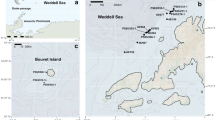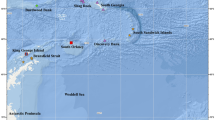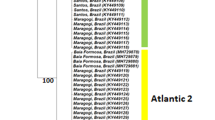Abstract
The native solitary ascidian Corella eumyota Traustedt, 1882) is commonly found in the Southern Hemisphere in the cold-temperate waters of the Subantarctic and Antarctic regions. Its recent spread into the Northern Hemisphere throughout the NE Atlantic gave the species the status of invasive. Together with its widespread distribution, reports on its wide variability (several distinct morphological characters, genetic discontinuities and also possible misidentifications) cast doubt on the taxonomic status of different populations of this species. This work, based on the observation, quantification and analysis of specific morphological characters in specimens collected at five different localities of South America and Antarctica, strongly indicates that there are two different species: C. eumyota from South America and Corella antarctica Sluiter, 1905) from Antarctica, which has been till now considered a junior synonym of the former. The species clearly differ in the arrangement of the gonadal ducts, the size of the larvae and the shape of the anus, among other characters. Morphological variation displays a defined, discrete grouping supporting a clear differentiation into two species. This result shows the need for careful inspection of specimens to avoid wrong interpretations in a context of changes of marine biota due to biological invasions.






Similar content being viewed by others
References
Arenas F, Bishop JDD, Carlton JT, Dyrynda PJ, Farnham WF, Gonzalez DJ, Jacobs MW, Lambert C, Lambert G, Nielsen SE, Pederson JA, Porter JS, Ward S, Wood CA (2006) Alien species and other notable records from a rapid assessment survey of marinas on the south coast of England. J Mar Biol Assoc UK 86:1329–1337. doi:10.1017/S0025315406014354
Ärnbäck-Christie-Linde A (1929) Chilean tunicates. Ascidians from the Guaitecas Islands. Arkiv Zool 21:1–25
Ärnbäck-Christie-Linde A (1938) Ascidiacea. Part I. Furth Zool Res Swed Antarct Exp 3(4):1–54
Balzarini MG, González L, Tablada M, Casanoves F, Di Rienzo JA, Robledo CW (2008) Infostat. Manual del Usuario. Editorial Brujas, Córdoba, p 336
Berner D (2011) Size correction in biology: how reliable are approaches based on (common) principal component analysis? Oecologia 166:961–971. doi:10.1007/s00442-011-1934-z
Bolton TF, Graham WM (2004) Morphological variation among populations of an invasive jellyfish. Mar Ecol Prog Ser 278:125–139
Boltovskoy D, Correa N, Boltovskoy A (2005) Diversity and endemism in cold waters of the South Atlantic: contrasting patterns in the plankton and the benthos. Sci Mar 69 (Suppl.2):17–26. doi:10.3989/scimar.2005.69s217
Bradbury IR, Laurel B, Snelgrove VR, Bentzen P, Campana SE (2008) Global patterns in marine dispersal estimates: the influence of geography, taxonomic category and life history. Proc R Soc B 275:1803–1809. doi:10.1098/rspb.2008.0216
Brewin B (1946) Ascidians in the vicinity of the Portobello marine biological station, Otago harbour. Trans R Soc NZ 76:87–131
Briggs JC (1995) Global biogeography. In: Developments in palaeontology and stratigraphy. Elsevier health sciences, Amsterdam
Clarke A, Crame JA (1989) The origin of the Southern Ocean marine fauna. Geol Soc 47:253–268. doi:10.1144/GSL.SP.1989.047.01.19 London, Special Publications
Collin SB, Oakley JA, Sewell J, Bishop JDD (2010) Widespread occurrence of the non-indigenous ascidian Corella eumyota Traustedt, 1882 on the shores of Plymouth Sound and Estuaries Special Area of Conservation, UK. Aquat Inv 5(2):1–5. doi:10.3391/ai.2010.5.2
Cowen RK, Sponaugle S (2009) Larval dispersal and marine population connectivity. Ann Rev Mar Sci 1:443–466. doi:10.1146/annurev.marine.010908.163757
Dawson MN (2003) Macro-morphological variation among cryptic species of the moon jellyfish, Aurelia (Cnidaria: Scyphozoa). Mar Biol 143:369–379. doi:10.1007/s00227-003-1070-3
Di Rienzo JA, Casanoves F, Balzarini MG, González L, Tablada M, Robledo CW (2011) InfoStat versión 2011. Grupo InfoStat, FCA, Universidad Nacional de Córdoba, Argentina. URL:http://www.infostat.com.ar
Dias GM, Abreu AG, Silva FOM, Solferini VN (2009) Microgeographical differentiation between morphotypes of Trididemnum orbiculatum (Tunicata: Ascidiacea) in southeastern Brazil. Aquat Biol 4:243–252. doi:10.3354/ab00115
Dupont L, Viard F, David P, Bishop JDD (2007) Combined effects of bottlenecks and selfing in populations of Corella eumyota, a recently introduced sea squirt in the English Channel. Divers Distrib 13:808–817. doi:10.1111/j.1472-4642.2007.00405.x
Hamer Ø, Harper DAT, Ryan PD (2001) PAST: paleontological statistics software package for education and data analysis. Paleontol Electron 4(1):9
Hedgpeth JM (1969) Introduction to Antarctic zoogeography. In: Bushnell VC, Hedgpeth JW (eds) Distribution of selected groups of marine invertebrates in waters south of 35º latitude. New York
Herdman WA (1882) Report on the Tunicata collected during the voyage of HMS “Challenger” during the years 1873–1878. Part. I, Ascidiae simplices. Rep sci Res Voy HMS Chall Zool 6(17):1–296
Herdman WA (1910) Tunicata. In: National Antarctic Expedition (S.S. Discovery) 1901–1904. Nat Hist 5:1–26
James FC, McCulloch CE (1990) Multivariate analysis in ecology and systematics: panacea or Pandora’s box. Annu Rev Ecol Syst 21:129–166
Kott P (1969) Antarctic Ascidiacea. A monographic account of the known species based on specimens collected under US government auspices 1947 to 1963. Antarct Res Ser 13:1–239
Lagger C, Häussermann V, Försterra G, Tatián M (2009) Ascidians from the southern Chilean Comau Fjord (Chordata, Ascidiacea). Spixiana 32(2):173–185
Lambert G (1968) The general ecology and growth of a solitary ascidian, Corella willmeriana. Biol Bull 135:296–307
Lambert G (2004) The south temperate and Antarctic ascidian Corella eumyota reported in two harbours in north-western France. J Mar Biol Assoc UK 84:239–241. doi:10.1017/S0025315404009105h
Lambert CL (2005) Historical introduction, overview, and reproductive biology of the protochordates. Can J Zool 83:1–7. doi:10.1139/Z04-160
Lambert G, Lambert CC, Abbott DP (1981) Corella species in the American Pacific Northwest: distinction of C. inflata Huntsman, 1912 from C. willmeriana Herdman, 1898 (Ascidiacea, Phlebobranchia). Can J Zool 59(8):1493–1504. doi:10.1139/z81-203
Lambert CL, Lambert IM, Lambert G (1995) Brooding strategies in solitary ascidians: Corella species from north and south temperate waters. Can J Zool 73:1666–1671. doi:10.1139/z95-198
Lanteri AA, Margaría C, Cingliano MM (2006) Análisis multivariado: técnicas de agrupamientos y árboles de distancia. In: Lanteri AA, Cigliano MM (eds) Sistemática biológica: fundamentos teóricos y ejercitaciones. EDULP, colección naturales, 3rd edn. Editorial de la UNLP, La Plata, pp 93–107
Locke A (2009) A screening procedure for potential tunicate invaders of Atlantic Canada. Aquat Inv 4(1):71–79. doi:10.3391/ai.2009.4.1.7
Lomolino MV, Riddle BR, Whittaker RJ, Brown JH (2010) The geography of diversification. In: Sinauer Associates (eds) Biogeography, 4th edn. Sunderland, pp 361–422
McCoy MW, Bolker BM, Osenberg CW, Miner BG, Vonesh JR (2006) Size correction: comparing morphological traits among populations and environments. Oecologia 148:547–554. doi:10.1007/s00442-006-0403-6
Millar RH (1960) Ascidiacea. Discov Rep 30:1–160
Miller KJ (1994) Morphological variation in the coral genus Platygyra: environmental influences and taxonomic implications. Mar Ecol Prog Ser 110:19–28
Minchin D (2007) A checklist of alien and cryptogenic aquatic species in Ireland. Aquat Inv 2(4):341–366. doi:10.3391/ai.2007.2.4.4
Monniot C, Monniot F (1972) Clé mondiale des genres d’Ascidies. Arch Zool Exp Gén 113(3):311–367
Monniot C, Monniot F (1974) Ascidies de la XXIIe expédition Antarctique Chilienne. Bol Soc Biol Concepción 48:365–383
Monniot C, Monniot F (1983) Ascidiens antarctiques et subantarctiques: morphologie et biogeographie. Mém Mus Natl Hist Nat Paris (A: Zool) 125:1–168
Monniot F, Dettai A, Eleaume M, Cruaud C, Ameziane N (2011) Antarctic Ascidians (Tunicata) of the French–Australian survey CEAMARC in Terre Adélie. Zootaxa 2817:1–54
Nagar AE, Huys R, Bishop JDD (2010) Widespread occurrence of the Southern Hemisphere ascidian Corella eumyota Traustedt, 1882 on the Atlantic coast of Iberia. Aquat Inv 5(2):1–5. doi:10.3391/ai.2010.5.2
Peck LS (2002) Ecophysiology of Antarctic marine ectotherms: limits to life. Polar Biol 25:31–40. doi:10.1007/s003000100308
Pörtner HO, Peck L, Somero G (2007) Thermal limits and adaptation in marine Antarctic ectotherms: an integrative view. Phil Trans R Soc B 362:2233–2258. doi:10.1098/rstb.2006.1947
Primo C, Vázquez E (2007) Zoogeography of the Antarctic ascidian fauna in relation to the sub-Antarctic and South America. Antarct Sci 1–16. doi: 10.1017/S0954102007000521
Primo C, Vázquez E (2009) Antarctic ascidians: an isolated and homogeneous fauna. Pol Res 28:403–414. doi:10.1111/j.1751-8369.2009.00110.x
Rius M, Teske PR (2011) A revision of the Pyura stolonifera species complex (Tunicata, Ascidiacea), with a description of a new species from Australia. Zootaxa 2754:27–40
Sahade R, Tatián M, Kowalke J, Kühne S, Esnal GB (1998) Benthic faunal associations on soft substrates at Potter Cove, King George Island, Antarctica. Polar Biol 19:85–91. doi:10.1007/s003000050218
Sluiter CP (1905) Note préliminaire sur les ascidiens Holostomates de l’Expedition Antarctique Française commandée par le Dr. Charcot. Bull Mus Natl Hist Nat Paris 11(6):470–475
Tarjuelo I, Posada D, Crandall KA, Pascual M, Turón X (2001) Cryptic species of Clavelina (Ascidiacea in two different habitat harbours and rocky littoral zones in the Northwestern Mediterranean. Mar Biol 139:455–462. doi:10.1007/s002270100587
Tatián M, Lagger C (2009) Ascidiacea. In: Häussermann V, Forsterra G (eds) Marine benthic fauna of Chilean Patagonia. Nature in Focus, Santiago, pp 1–1000
Tatián M, Sahade R, Doucet ME, Esnal GB (1998) Ascidians (Tunicata, Ascidiacea) of Potter Cove, South Shetland Islands, Antarctica. Antarct Sci 10(2):147–152. doi:10.1017/S0954102098000194
Tatián M, Antacli JC, Sahade R (2005) Ascidians (Tunicata, Ascidiacea): species distribution along the Scotia Arc. Sci Mar 69(Suppl. 2):205–214
Tatián M, Schwindt E, Lagger C, Varela MM (2010) Colonization of Patagonian harbors (SW Atlantic) by an invasive sea squirt (Chordata, Ascidiacea). Spixiana 33(1):111–117
Therriault TW, Herborg L-M (2008) Predicting the potential distribution of the vase tunicate Ciona intestinalis in Canadian waters: informing a risk assessment. ICES J Mar Sci 65:788–794
Thornhill DJ, Mahon AR, Norenburg JL, Halanych KM (2008) Open-ocean barriers to dispersal: a test case with the Antarctic Polar Front and the ribbon worm Parborlasia corrugatus (Nemertea: Lineidae). Mol Ecol 17:5104–5117. doi:10.1111/j.1365-294X.2008.03970.x
Traustedt MPA (1882) Ventindiske Ascidiae simplices. Først Afd. (Phallusidae). Vidensk Meddel Naturhist Foren Kjöbenhaven, ann 1881:257–288
Turón X (1988) Some ascidians from Namibia (SW Africa). Monogr Zool Mar 3:267–291
Van Beneden E, de Selys Longchamps M (1913) Zoologie: Tuniciers, Caducichordata (Ascidiacés et Thaliacés). Résultats du Voyage du S.Y. Belgica en 1897–1898–1899 sous le commandenment de A. Gerlache de Gomery: Rapports Scientifiques (1901–1913)
Van Name WG (1945) The North and South American ascidians. Bull Am Mus Nat Hist 84:476
Varela MM, De Matos-Pita SS, Ramil F, Ramos-Esplá AA (2007) New report of the Antarctic ascidian Corella eumyota (Tunicata, Ascidiacea) in Galicia coast (NW Spain). Mar Biodivers Rec 1:e59. doi:10.1017/S1755267207006574
Weersing K, Toonen RJ (2009) Population genetics, larval dispersal, and connectivity in marine systems. Mar Ecol Prog Ser 393:1–12. doi:10.3354/meps08287
Acknowledgments
The authors want to thank Dr. Gretchen Lambert for her kind help and valuable advice on gonadal duct observation, and through her to Dr. Claus Nielsen (Rijksmuseum in Copenhagen, Denmark) for the translation, from Danish to English, of the original description of C. eumyota and also to Biol. Cristian Lagger by their dedicated and thorough review of the manuscript and valuable comments that greatly improved this work. We also thank Ward Appeltans (WoRMS) and Chilekwa Chisala (Flanders Marine Institute Library) for helping us get the original Traustedt description (1882). Finally, we thank all the reviewers whose recommendations and observations have led to a great improvement of this manuscript. This study was supported by the Consejo Nacional de Investigaciones Científicas y Técnicas (CONICET), Dirección Nacional del Antártico (DNA)/Instituto Antártico Argentino (IAA) and Universidad Nacional de Córdoba (UNC). This work was partially funded by PICTO 2010-0019 (ANPCyT-DNA), PIP CONICET No 11220100100089, SECyT (05/I602), Universidad Nacional de Córdoba, ECLIPSE (Total Foundation), PICT 20621 and Proyecto ARG/PNUD ARG 02/018 Subproyecto AB-54. TWAS Fellowship for Postdoctoral Research and Advanced Training and CONICET provided support to Evangelina Scwindt for the visit at the P. Universidad Católica, Chile.
Author information
Authors and Affiliations
Corresponding author
Rights and permissions
About this article
Cite this article
Alurralde, G., Torre, L., Schwindt, E. et al. A re-evaluation of morphological characters of the invasive ascidian Corella eumyota reveals two different species at the tip of South America and in the South Shetland Islands, Antarctica. Polar Biol 36, 957–968 (2013). https://doi.org/10.1007/s00300-013-1319-3
Received:
Revised:
Accepted:
Published:
Issue Date:
DOI: https://doi.org/10.1007/s00300-013-1319-3




